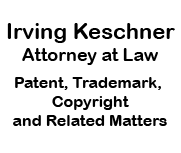Patents
Determination as to Whether a Patent Application or Invention Should Be Filed in the United States Patent and Trademark 0ffice.
Although not required, it is recommended that a prior art, or patentability, search be conducted to ascertain whether patent protection is available (the search is a screening process the results thereof not in itself being a final determination of patentability). The results of the search will be reviewed and the client advised whether patent protection may be available.
Preparation and Filing of Patent Application
If the results of the patentability search indicates that patent protection is available and the client authorizes filing a patent application, the necessary information will be acquired to meet the requirements of the patent law, prepare drawings and have the inventor review an initial draft. Comments and modifications suggested by the inventor will be considered and incorporated in the application if necessary. The final version of the application will then be prepared for the inventor's signature The application will then be forwarded to the Patent and Trademark Office ("PTO"), the inventor thereafter being informed of the filing data (filing date and serial number).
Prosecution of Application in PTO
The application, once filed, will be reviewed by a patent examiner. The process will involve the interaction between applicant's attorney and the examiner until a determination is made whether a patent should be issued. If the examiner decides the application is allowable, a patent will issue in due course upon meeting certain formal requirements. If the examiner determines that a patent should not issue, the client has an option to pursue the matter further.
Foreign Patent Protection
Patent protection is available in most countries; contact Mr. Keschner for details.
Trademarks
Determination as to Whether Chosen Mark Should be Used on Product or for Services
Before deciding to invest in artwork for a tradename, trademark and/or service mark for your business, a search should be conducted to ascertain whether someone else is already using the mark or a confusingly similar mark.
Filing For Federal Registration of Mark
Assuming the search has not developed a mark which would preclude the mark chosen by client, the next step would be file a federal trademark/service mark application in the PTO. The application can be based on actual use in commerce (interstate or foreign) or on an intent-to-use.
Prosecution of Application in PTO
The application, once filed, will be reviewed by a trademark attorney. The process will involve the interaction between applicant's representative and the trademark attorney until a determination is made whether the mark will be registered. If the trademark attorney determines that the mark should be registered, the mark is published for opposition purposes. If no opposition is timely filed, the mark will become registered (for an intent-to-use application, proof of use in commerce has to be shown before the mark will be registered). If the trademark attorney decides that the mark should not be registered, the client has the option to pursue the matter further.
Foreign Trademark/Service Mark Protection
Trademark/service mark protection is available in most countries; contact Mr. Keschner for details.
Avoiding Infringement of a Third Party
The opposite situation of protecting a client's rights is to insure that your client doesn't infringe the patent, trademark, copyright and/or trade secret rights of a third party. In this context it should be noted, for example, that obtaining a corporate name may not in itself preclude the situation wherein the corporate name may infringe the trademark rights of a third party. Procedures are available to minimize the risks of such infringement. Click here to view a chart comparing the different forms of intellectual property.
Internet Domain Names
TA number of disputes have arisen recently regarding the use of domain names that conflict with the trademarks of third parties. In this regard, a dispute policy, (UDRP) has been established that permits the owner of a mark to initiate an administrative complaint against the user of a confusingly similar domain name. If the administrative procedure is unsuccessful, remedies can be sought through litigation.
